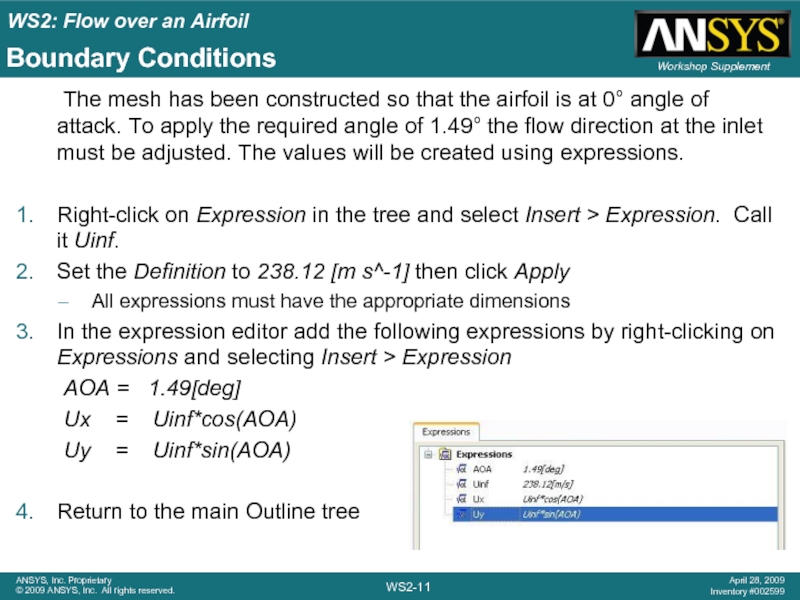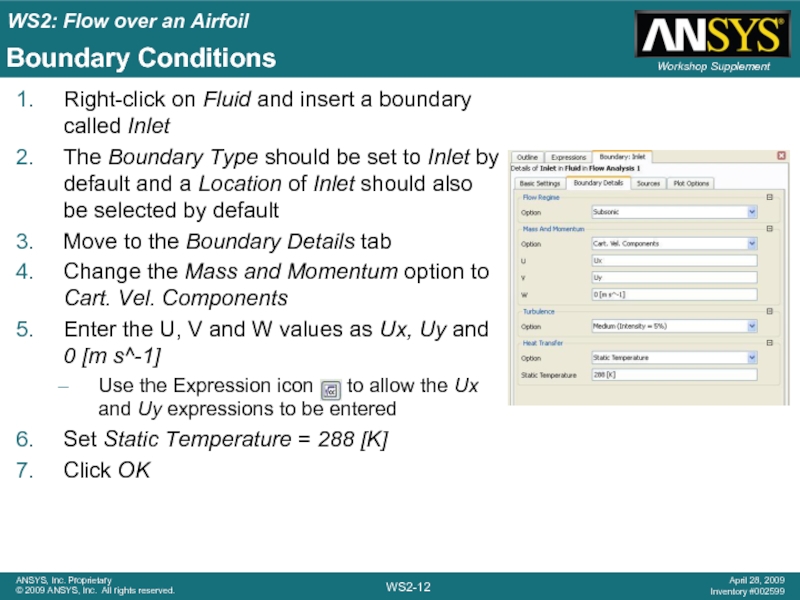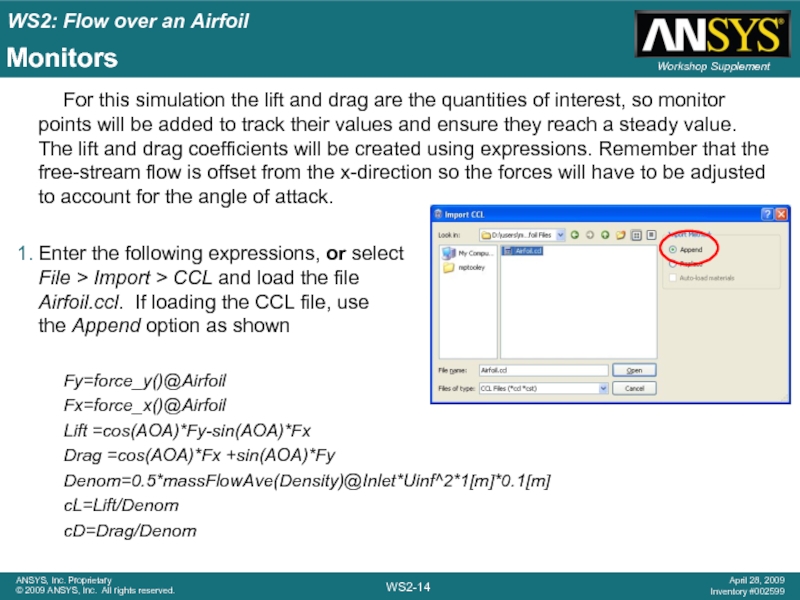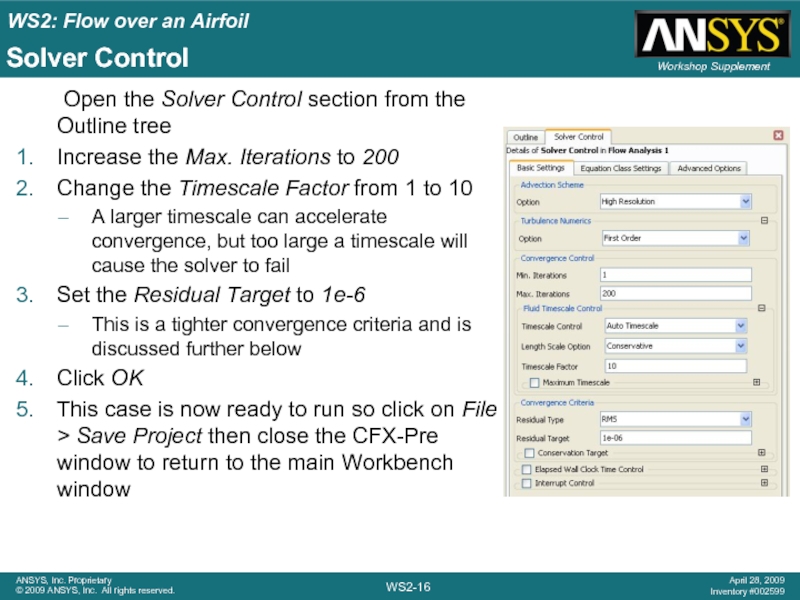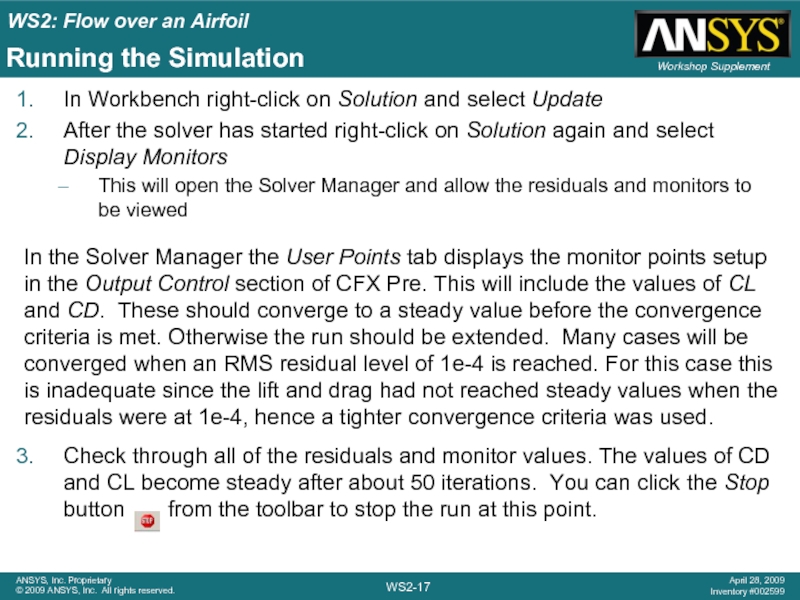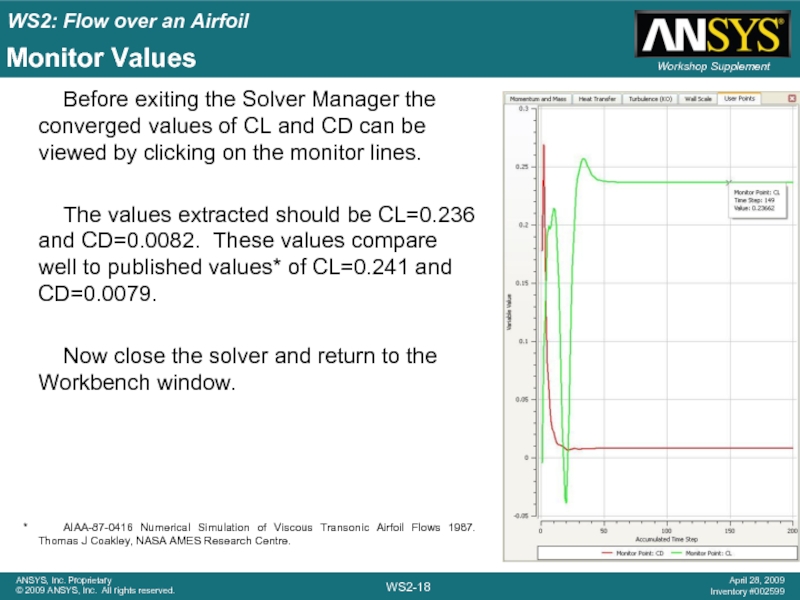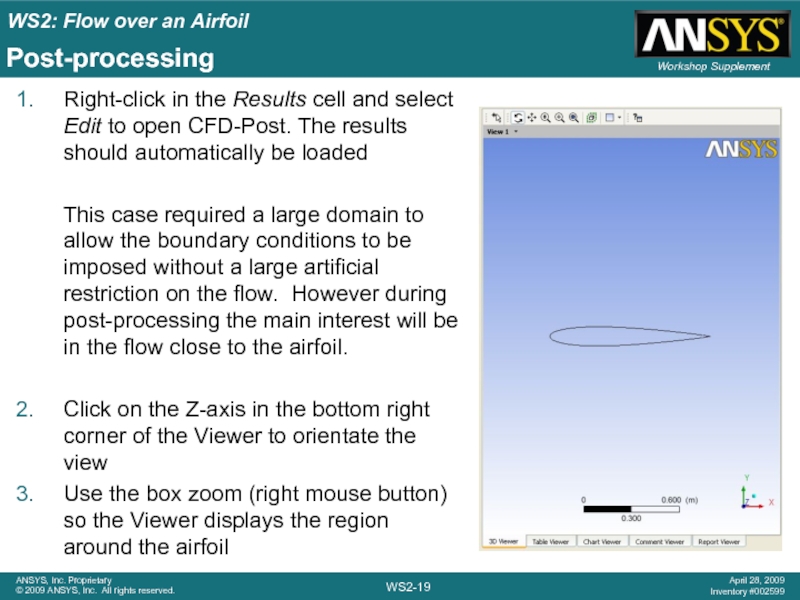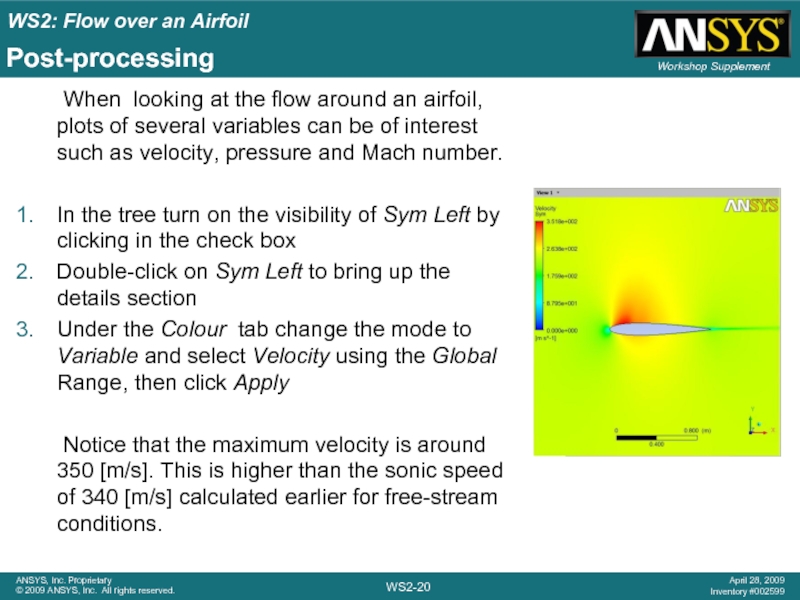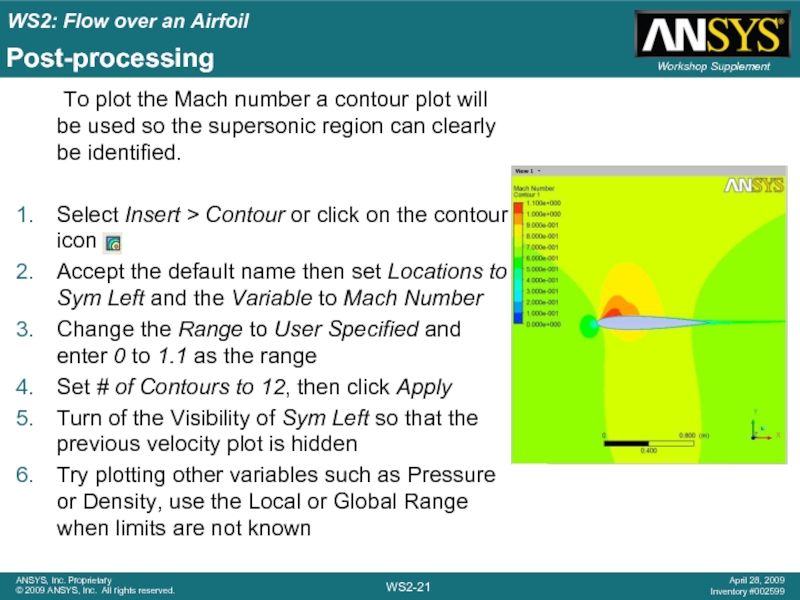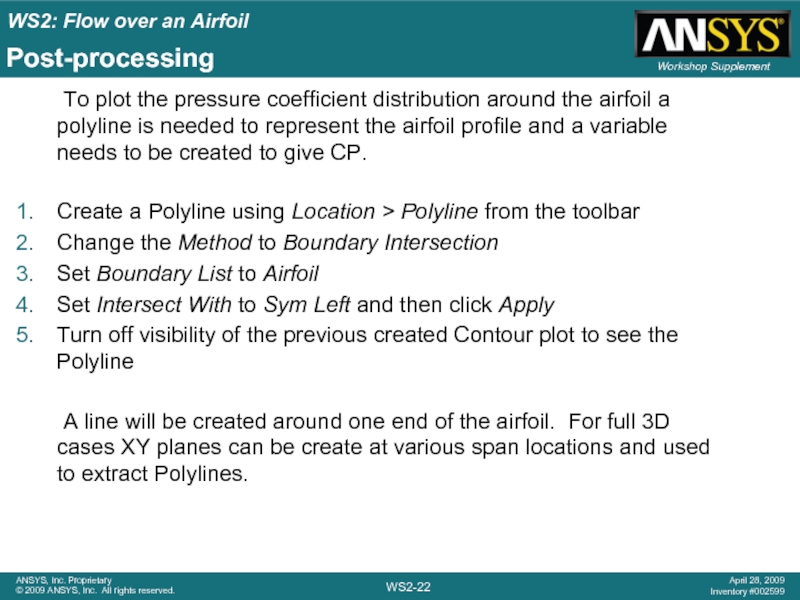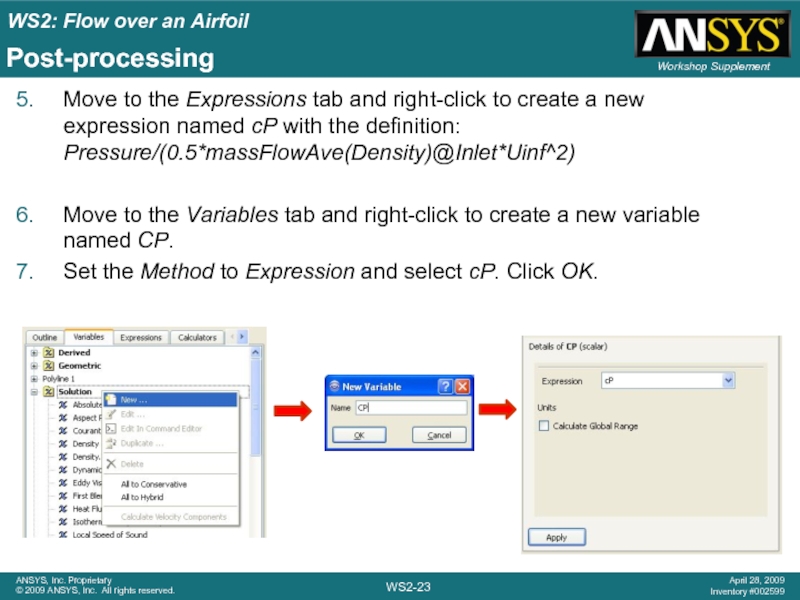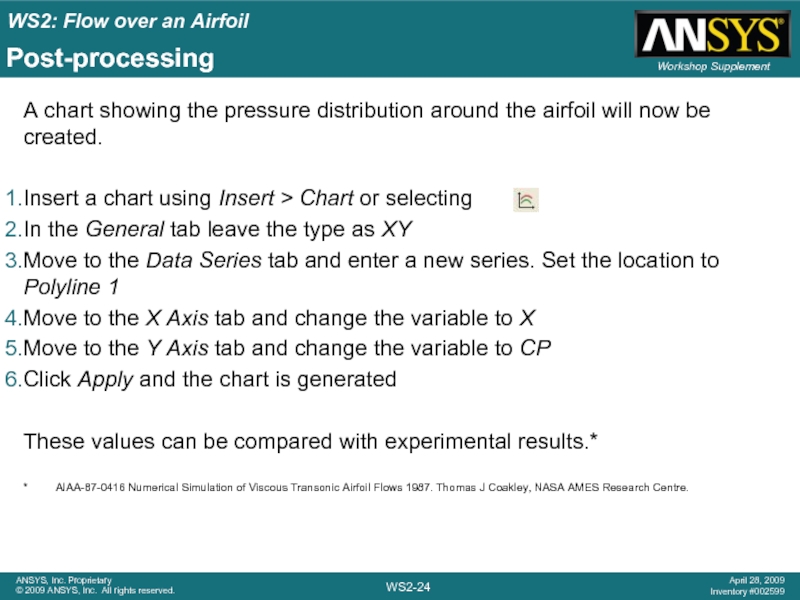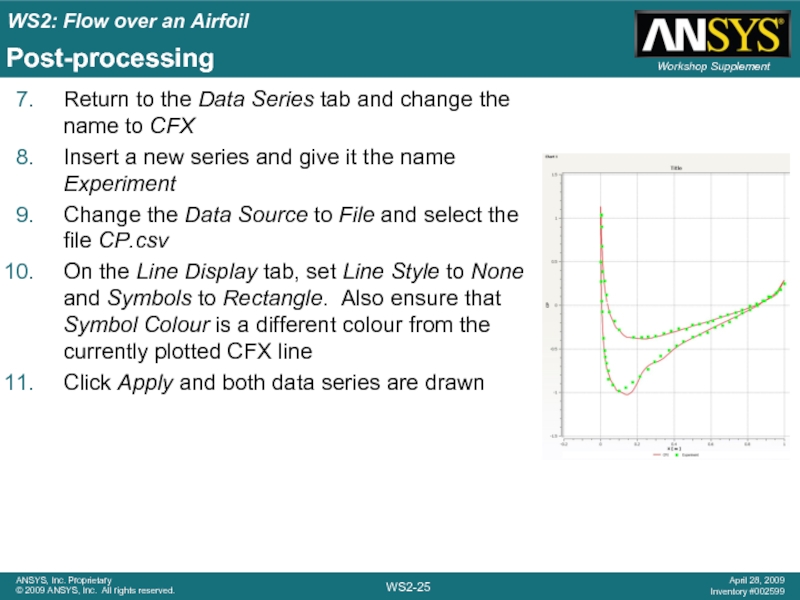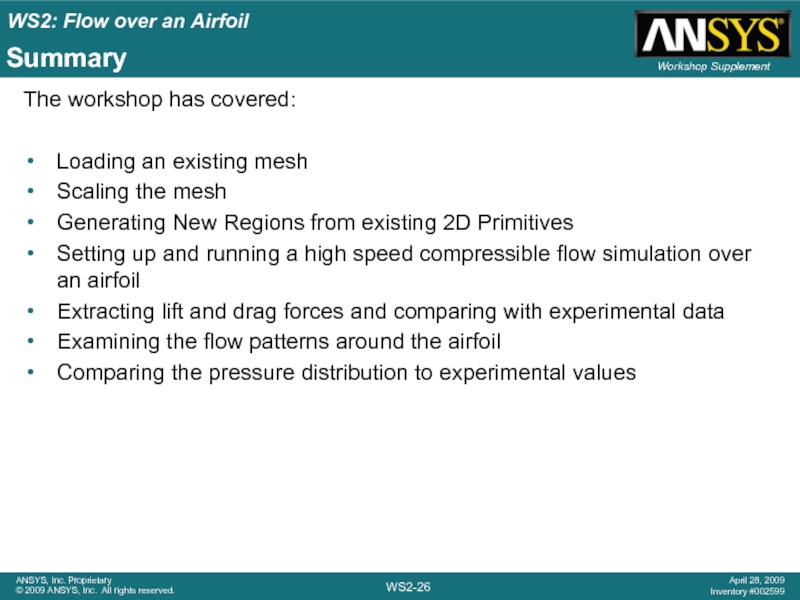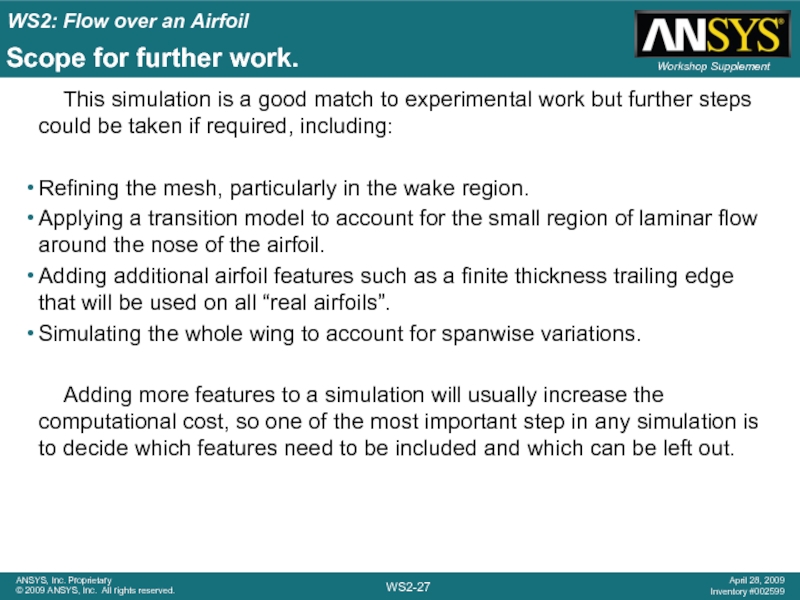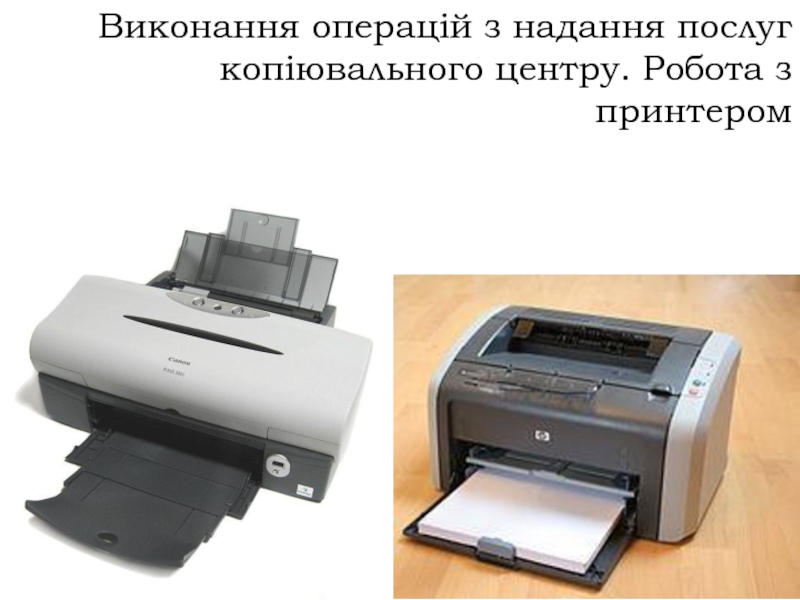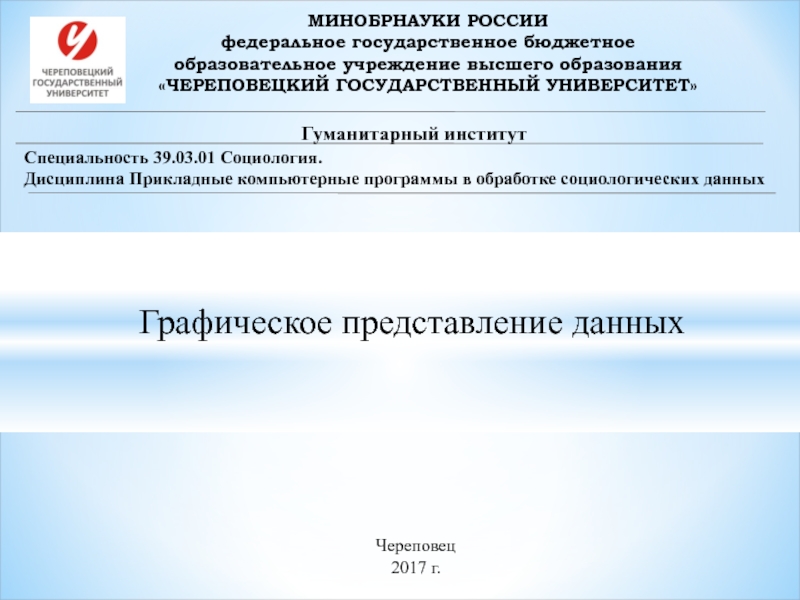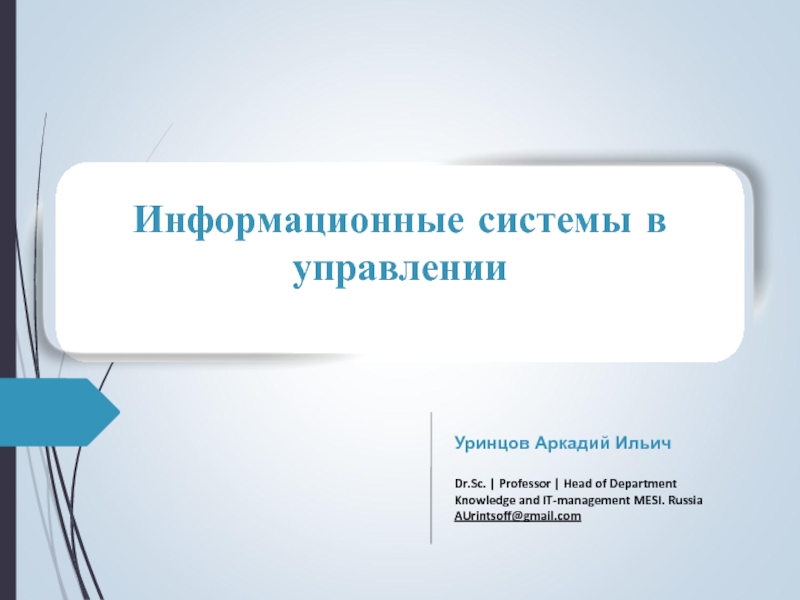- Главная
- Разное
- Дизайн
- Бизнес и предпринимательство
- Аналитика
- Образование
- Развлечения
- Красота и здоровье
- Финансы
- Государство
- Путешествия
- Спорт
- Недвижимость
- Армия
- Графика
- Культурология
- Еда и кулинария
- Лингвистика
- Английский язык
- Астрономия
- Алгебра
- Биология
- География
- Детские презентации
- Информатика
- История
- Литература
- Маркетинг
- Математика
- Медицина
- Менеджмент
- Музыка
- МХК
- Немецкий язык
- ОБЖ
- Обществознание
- Окружающий мир
- Педагогика
- Русский язык
- Технология
- Физика
- Философия
- Химия
- Шаблоны, картинки для презентаций
- Экология
- Экономика
- Юриспруденция
Transonic Flow Over a NACA 0012 Airfoil презентация
Содержание
- 1. Transonic Flow Over a NACA 0012 Airfoil
- 2. Goals The purpose of this tutorial is
- 3. Start a Workbench project Launch Workbench Save
- 4. Mesh Modification Open CFX-pre by right-clicking on
- 5. Mesh Modification The mesh has been
- 6. Mesh Modification The remaining section will
- 7. Domain Setup Usually the option to automatically
- 8. Domain Setup This case involves high speed
- 9. Domain Setup In the Fluid domain Basic
- 10. Boundary Conditions An outlet relative pressure of
- 11. Boundary Conditions The mesh has been
- 12. Boundary Conditions Right-click on Fluid and insert
- 13. Boundary Conditions The Viewer indicates the locations
- 14. Monitors For this simulation the lift and
- 15. Monitors Edit Output Control from the Outline
- 16. Solver Control Open the Solver Control section
- 17. Running the Simulation In Workbench right-click on
- 18. Monitor Values Before exiting the Solver Manager
- 19. Post-processing Right-click in the Results cell and
- 20. Post-processing When looking at the flow around
- 21. Post-processing To plot the Mach number a
- 22. Post-processing To plot the pressure coefficient distribution
- 23. Post-processing Move to the Expressions tab and
- 24. Post-processing A chart showing the pressure distribution
- 25. Post-processing Return to the Data Series tab
- 26. Summary The workshop has covered: Loading
- 27. Scope for further work. This simulation is
Слайд 2Goals
The purpose of this tutorial is to introduce the user to
In this case the flow over a NACA 0012 airfoil at an angle of attach of 1.49° will be simulated and the lift and drag values will be compared to published results. These results were taken with a Reynolds number of 9x106 and a chord length of 1m.*
The airfoil is travelling at Mach 0.7 so the simulation will need to account for compressibility as well as turbulence effects.
To reduce the computational cost, the mesh will be made up of a 2D slice through the airfoil (one element thick).
* NASA TM 81927 Two-Dimensional Aerodynamic Characteristics of the NACA 0012 Airfoil in the Langley 8-Foot Transonic Pressure Tunnel 1981. Harris, C. D.
Слайд 3Start a Workbench project
Launch Workbench
Save the new project as naca0012 in
Drag a Fluid Flow (CFX) module from the Analysis Systems section of the Toolbox onto the Project Schematic
In the Project Schematic right-click on the Mesh cell and select Import Mesh File
Set the file filter to FLUENT Files and select NACA0012.msh
With the mesh file imported the Geometry cell will not be needed so it is removed from the Fluid Flow module.
Note that you could have dragged Component System > CFX onto the Project Schematic, as in the first workshop. The mesh would then be imported after starting CFX-Pre.
Слайд 4Mesh Modification
Open CFX-pre by right-clicking on the Setup cell and selecting
After CFX-Pre has opened the mesh can be examined and it is clear that the scale is incorrect as the airfoil chord is 1000 m rather than 1 m, indicating the mesh was built in mm rather than m. This can be fixed using the mesh transformation options.
Right-click on Mesh in the Outline tree and select Transform Mesh
Change the Transformation to Scale
Leave the method to Uniform and enter a Uniform Scale of 0.001
Click OK
Select the Fit View icon from the Viewer toolbar
Zoom in further to see the airfoil
Слайд 5Mesh Modification
The mesh has been built to have a single
Right-click Mesh in the Outline tree and select Insert > Primitive Region
Click on the Start Picking button
From the drop down selection menu select Flood Select (see image to the right)
In the viewer select any element from the front curved boundary
The flood fill will select all cells where the change in angle is less than 30°
Click in the Move Faces To field and type Inlet
Click OK
Inlet
Outlet
Слайд 6Mesh Modification
The remaining section will now be renamed “Outlet”.
Expand
Click on the region pressure far field 1 to confirm it is the region representing the outlet
It will be highlighted in the Viewer
Right-click on pressure far field 1 and select Rename. Change the name to Outlet
Слайд 7Domain Setup
Usually the option to automatically generate domains is active, this
Check that Automatic Default Domain is active the click OK.
Right-click on Default Domain in the Outline tree and rename it to Fluid
Double-click on Fluid to edit the domain settings
Слайд 8Domain Setup
This case involves high speed aerodynamics so it is important
It is important to set the correct operating pressure so that the intended Reynolds number is achieved. The simulation will take place at 288 [K] in air; this allows the speed of sound to be calculated. This can then be converted into a free-stream velocity using the Mach number. Using the definition for Reynolds number the fluid density can be obtained, which can then be used to determine the operating pressure for the simulation, assuming an ideal gas.
c =Speed of sound
R=Gas Constant
γ =Ratio of specific heats
T=Temperature
u= Free-stream velocity
M=Mach number
Re=Reynolds number
μ= Dynamic viscosity
ρ= Density
Слайд 9Domain Setup
In the Fluid domain Basic Settings tab:
Set the Material to
Set the Reference Pressure to 56867 [Pa]
Make sure you change set the units
Move to the Fluid Models tab
Set the Heat Transfer Option to Total Energy
This is required for compressible simulations
Enable Incl. Viscous Work Term
This includes viscous heating effects
Set the Turbulence Option to Shear Stress Transport
Click OK
Слайд 10Boundary Conditions
An outlet relative pressure of 0 [Pa] will now be
Absolute Pressure = Reference Pressure + Relative Pressure
Right-click on the domain Fluid in the Outline tree and select Insert > Boundary, naming the boundary Outlet
Change the Boundary Type to Outlet and check that the location is set to Outlet
Move to the Boundary Details tab and set the Mass and Momentum option to Average Static Pressure with a value of 0 [Pa]
Click OK
The sides of the domain will use symmetry conditions since this is a 2D simulation.
Insert a Symmetry boundary called Sym Left, at the location sym left
Insert a Symmetry boundary called Sym Right, at the location sym right
Слайд 11Boundary Conditions
The mesh has been constructed so that the airfoil
Right-click on Expression in the tree and select Insert > Expression. Call it Uinf.
Set the Definition to 238.12 [m s^-1] then click Apply
All expressions must have the appropriate dimensions
In the expression editor add the following expressions by right-clicking on Expressions and selecting Insert > Expression
AOA = 1.49[deg]
Ux = Uinf*cos(AOA)
Uy = Uinf*sin(AOA)
Return to the main Outline tree
Слайд 12Boundary Conditions
Right-click on Fluid and insert a boundary called Inlet
The Boundary
Move to the Boundary Details tab
Change the Mass and Momentum option to Cart. Vel. Components
Enter the U, V and W values as Ux, Uy and 0 [m s^-1]
Use the Expression icon to allow the Ux and Uy expressions to be entered
Set Static Temperature = 288 [K]
Click OK
Слайд 13Boundary Conditions
The Viewer indicates the locations of the inlet and outlet
The final boundary condition is the wall around the airfoil. This should already exist as Fluid Default.
Edit Fluid Default to check that only the wall bottom and wall top regions remain in the default boundary
Click Close
Rename Fluid Default to Airfoil
Слайд 14Monitors
For this simulation the lift and drag are the quantities of
Enter the following expressions, or select File > Import > CCL and load the file Airfoil.ccl. If loading the CCL file, use the Append option as shown
Fy=force_y()@Airfoil
Fx=force_x()@Airfoil
Lift =cos(AOA)*Fy-sin(AOA)*Fx
Drag =cos(AOA)*Fx +sin(AOA)*Fy
Denom=0.5*massFlowAve(Density)@Inlet*Uinf^2*1[m]*0.1[m]
cL=Lift/Denom
cD=Drag/Denom
Слайд 15Monitors
Edit Output Control from the Outline tree and go to the
Check the Monitor Options box
Click on the Add New Item icon and name it CL
Set the Option to Expression and enter cL
This is the monitor point for the Coefficient of Lift. Note that all names and expressions are case sensitive, so the monitor point is named “CL” and it refers to the expression named “cL”.
Add a new item called CD and set it to the expression cD
This is the Coefficient of Drag
Click OK
Слайд 16Solver Control
Open the Solver Control section from the Outline tree
Increase the
Change the Timescale Factor from 1 to 10
A larger timescale can accelerate convergence, but too large a timescale will cause the solver to fail
Set the Residual Target to 1e-6
This is a tighter convergence criteria and is discussed further below
Click OK
This case is now ready to run so click on File > Save Project then close the CFX-Pre window to return to the main Workbench window
Слайд 17Running the Simulation
In Workbench right-click on Solution and select Update
After the
This will open the Solver Manager and allow the residuals and monitors to be viewed
Check through all of the residuals and monitor values. The values of CD and CL become steady after about 50 iterations. You can click the Stop button from the toolbar to stop the run at this point.
In the Solver Manager the User Points tab displays the monitor points setup in the Output Control section of CFX Pre. This will include the values of CL and CD. These should converge to a steady value before the convergence criteria is met. Otherwise the run should be extended. Many cases will be converged when an RMS residual level of 1e-4 is reached. For this case this is inadequate since the lift and drag had not reached steady values when the residuals were at 1e-4, hence a tighter convergence criteria was used.
Слайд 18Monitor Values
Before exiting the Solver Manager the converged values of CL
The values extracted should be CL=0.236 and CD=0.0082. These values compare well to published values* of CL=0.241 and CD=0.0079.
Now close the solver and return to the Workbench window.
* AIAA-87-0416 Numerical Simulation of Viscous Transonic Airfoil Flows 1987. Thomas J Coakley, NASA AMES Research Centre.
Слайд 19Post-processing
Right-click in the Results cell and select Edit to open CFD-Post.
This case required a large domain to allow the boundary conditions to be imposed without a large artificial restriction on the flow. However during post-processing the main interest will be in the flow close to the airfoil.
Click on the Z-axis in the bottom right corner of the Viewer to orientate the view
Use the box zoom (right mouse button) so the Viewer displays the region around the airfoil
Слайд 20Post-processing
When looking at the flow around an airfoil, plots of several
In the tree turn on the visibility of Sym Left by clicking in the check box
Double-click on Sym Left to bring up the details section
Under the Colour tab change the mode to Variable and select Velocity using the Global Range, then click Apply
Notice that the maximum velocity is around 350 [m/s]. This is higher than the sonic speed of 340 [m/s] calculated earlier for free-stream conditions.
Слайд 21Post-processing
To plot the Mach number a contour plot will be used
Select Insert > Contour or click on the contour icon
Accept the default name then set Locations to Sym Left and the Variable to Mach Number
Change the Range to User Specified and enter 0 to 1.1 as the range
Set # of Contours to 12, then click Apply
Turn of the Visibility of Sym Left so that the previous velocity plot is hidden
Try plotting other variables such as Pressure or Density, use the Local or Global Range when limits are not known
Слайд 22Post-processing
To plot the pressure coefficient distribution around the airfoil a polyline
Create a Polyline using Location > Polyline from the toolbar
Change the Method to Boundary Intersection
Set Boundary List to Airfoil
Set Intersect With to Sym Left and then click Apply
Turn off visibility of the previous created Contour plot to see the Polyline
A line will be created around one end of the airfoil. For full 3D cases XY planes can be create at various span locations and used to extract Polylines.
Слайд 23Post-processing
Move to the Expressions tab and right-click to create a new
Move to the Variables tab and right-click to create a new variable named CP.
Set the Method to Expression and select cP. Click OK.
Слайд 24Post-processing
A chart showing the pressure distribution around the airfoil will now
Insert a chart using Insert > Chart or selecting
In the General tab leave the type as XY
Move to the Data Series tab and enter a new series. Set the location to Polyline 1
Move to the X Axis tab and change the variable to X
Move to the Y Axis tab and change the variable to CP
Click Apply and the chart is generated
These values can be compared with experimental results.*
* AIAA-87-0416 Numerical Simulation of Viscous Transonic Airfoil Flows 1987. Thomas J Coakley, NASA AMES Research Centre.
Слайд 25Post-processing
Return to the Data Series tab and change the name to
Insert a new series and give it the name Experiment
Change the Data Source to File and select the file CP.csv
On the Line Display tab, set Line Style to None and Symbols to Rectangle. Also ensure that Symbol Colour is a different colour from the currently plotted CFX line
Click Apply and both data series are drawn
Слайд 26Summary
The workshop has covered:
Loading an existing mesh
Scaling the mesh
Generating New Regions
Setting up and running a high speed compressible flow simulation over an airfoil
Extracting lift and drag forces and comparing with experimental data
Examining the flow patterns around the airfoil
Comparing the pressure distribution to experimental values
Слайд 27Scope for further work.
This simulation is a good match to experimental
Refining the mesh, particularly in the wake region.
Applying a transition model to account for the small region of laminar flow around the nose of the airfoil.
Adding additional airfoil features such as a finite thickness trailing edge that will be used on all “real airfoils”.
Simulating the whole wing to account for spanwise variations.
Adding more features to a simulation will usually increase the computational cost, so one of the most important step in any simulation is to decide which features need to be included and which can be left out.
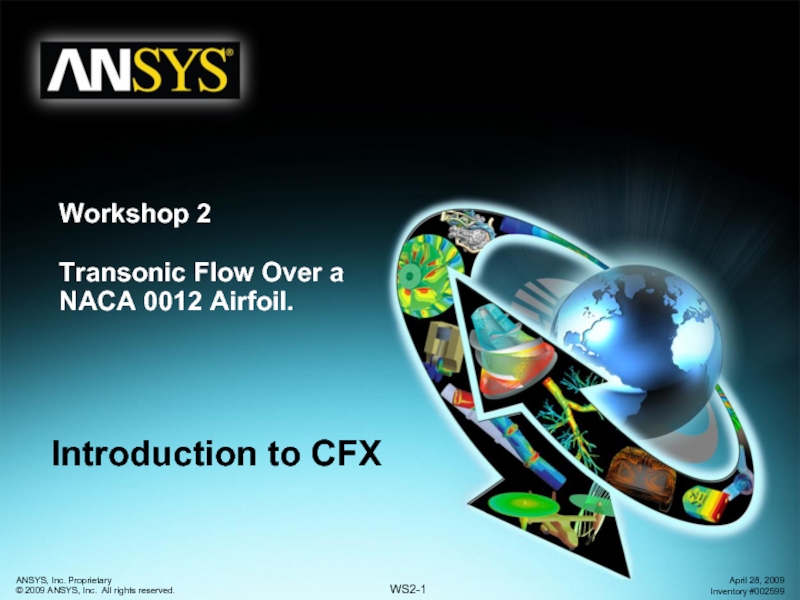
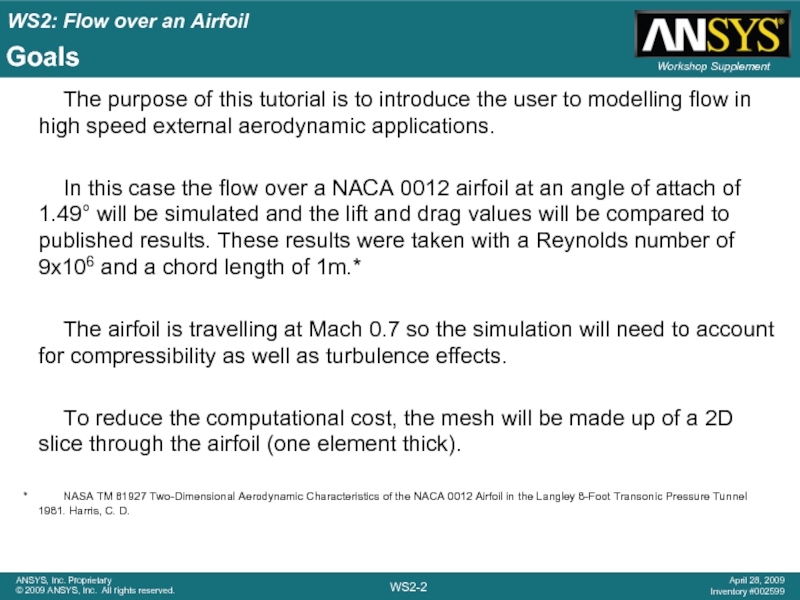
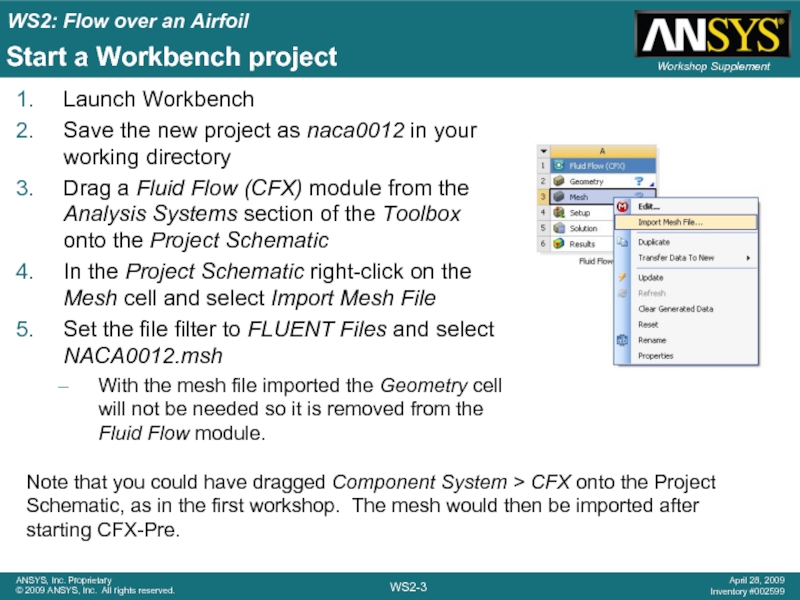
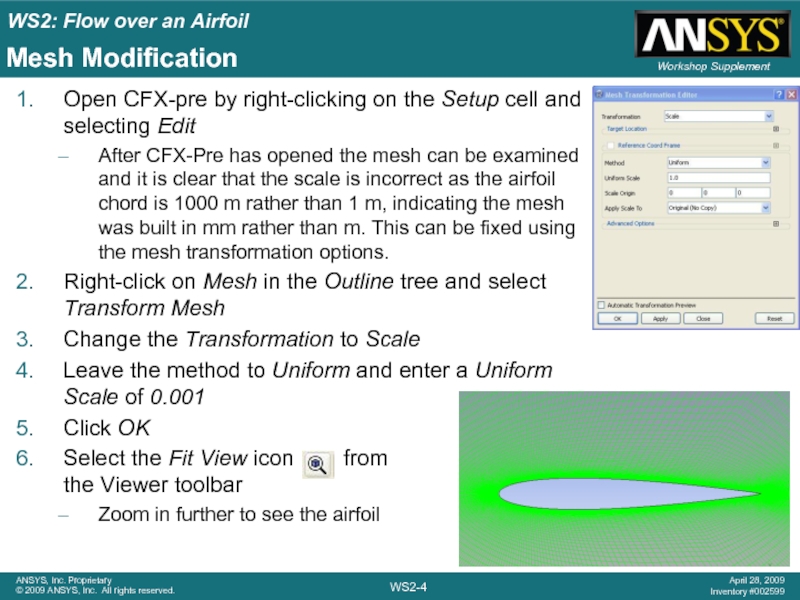
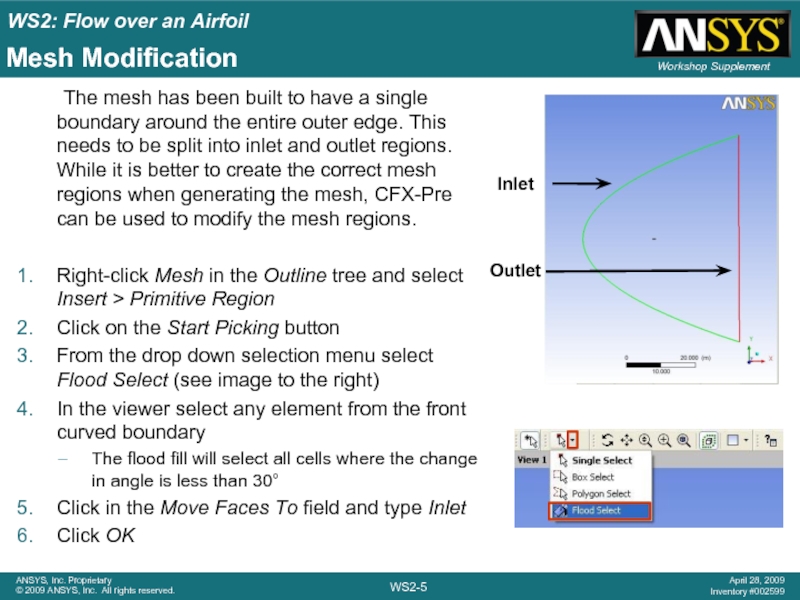
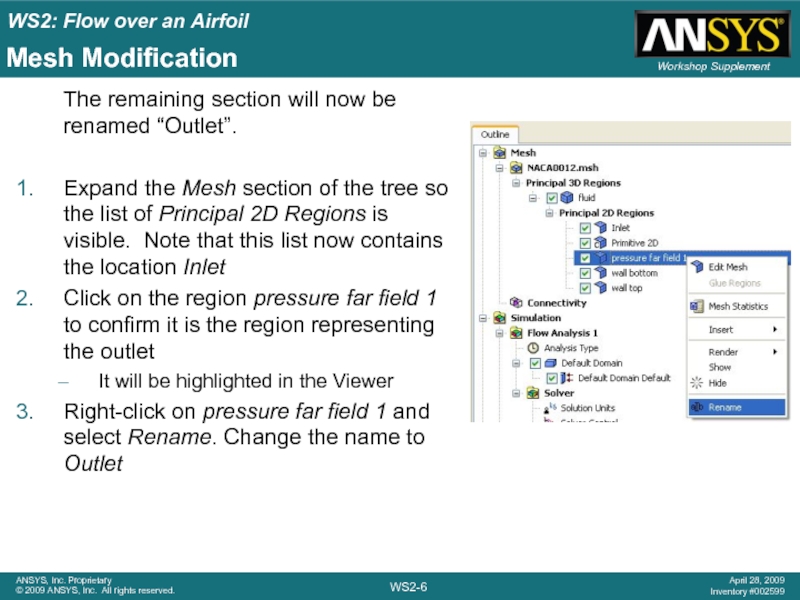

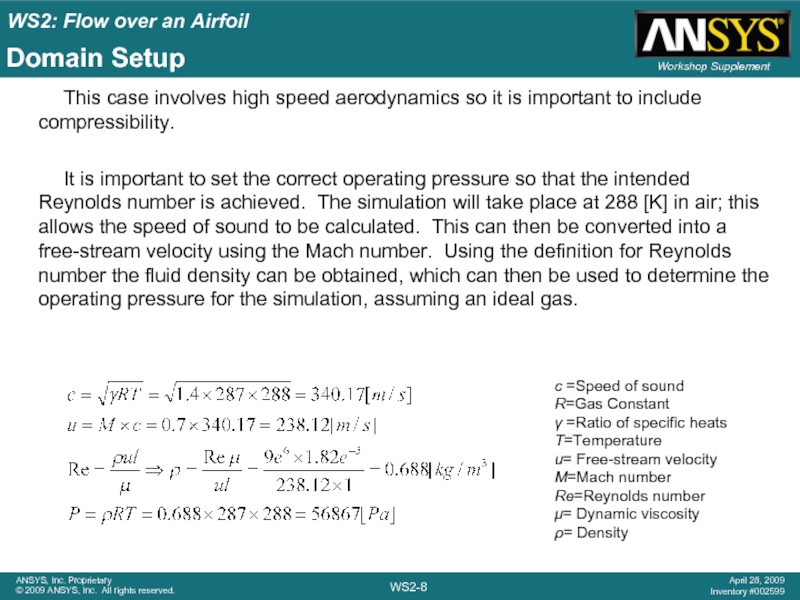
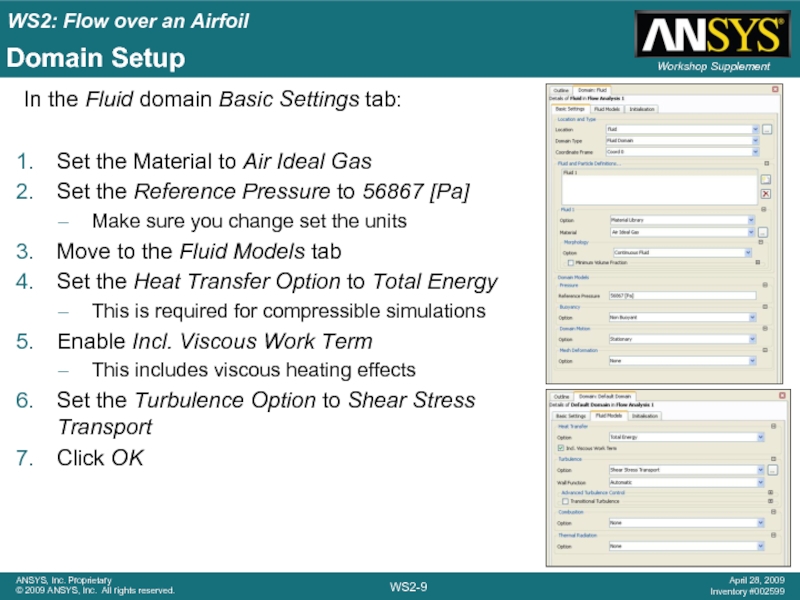
![Boundary Conditions An outlet relative pressure of 0 [Pa] will now be applied. This pressure is](/img/tmb/2/116903/a55ce05d24dbd20e865c9666663650a8-800x.jpg)
